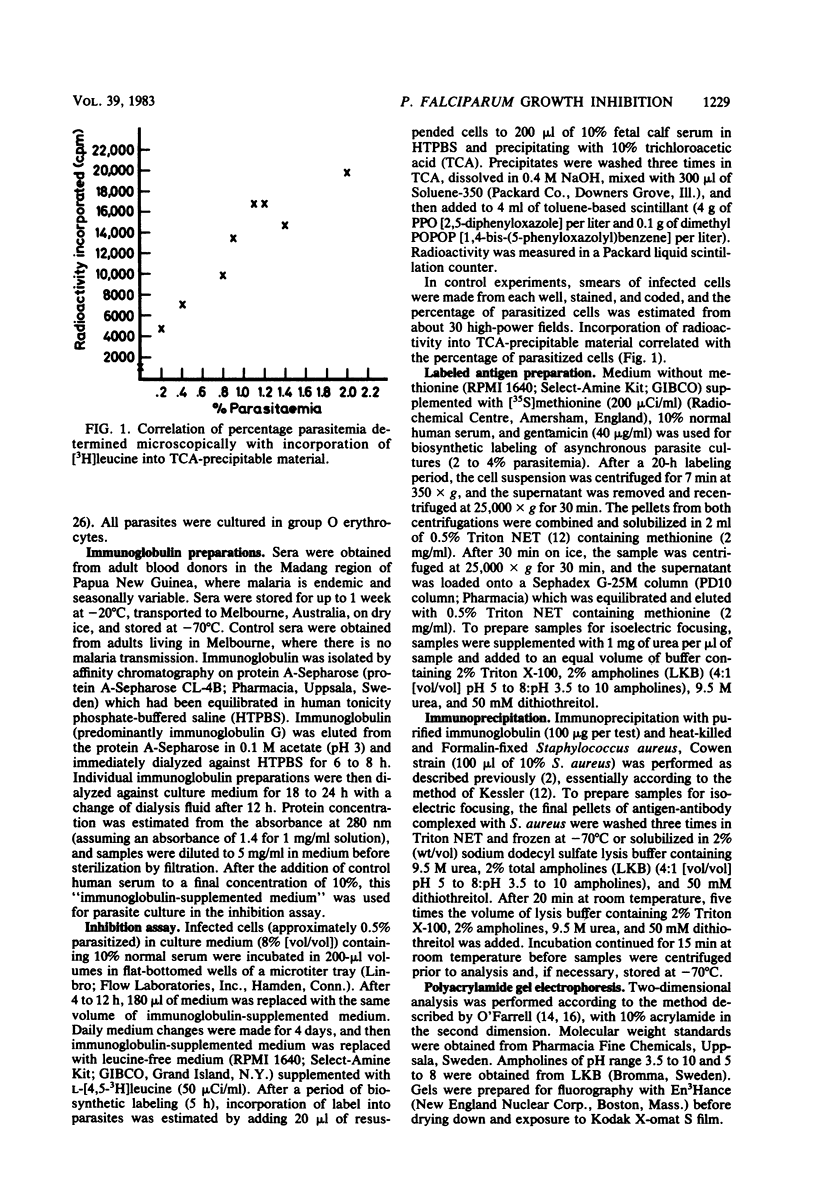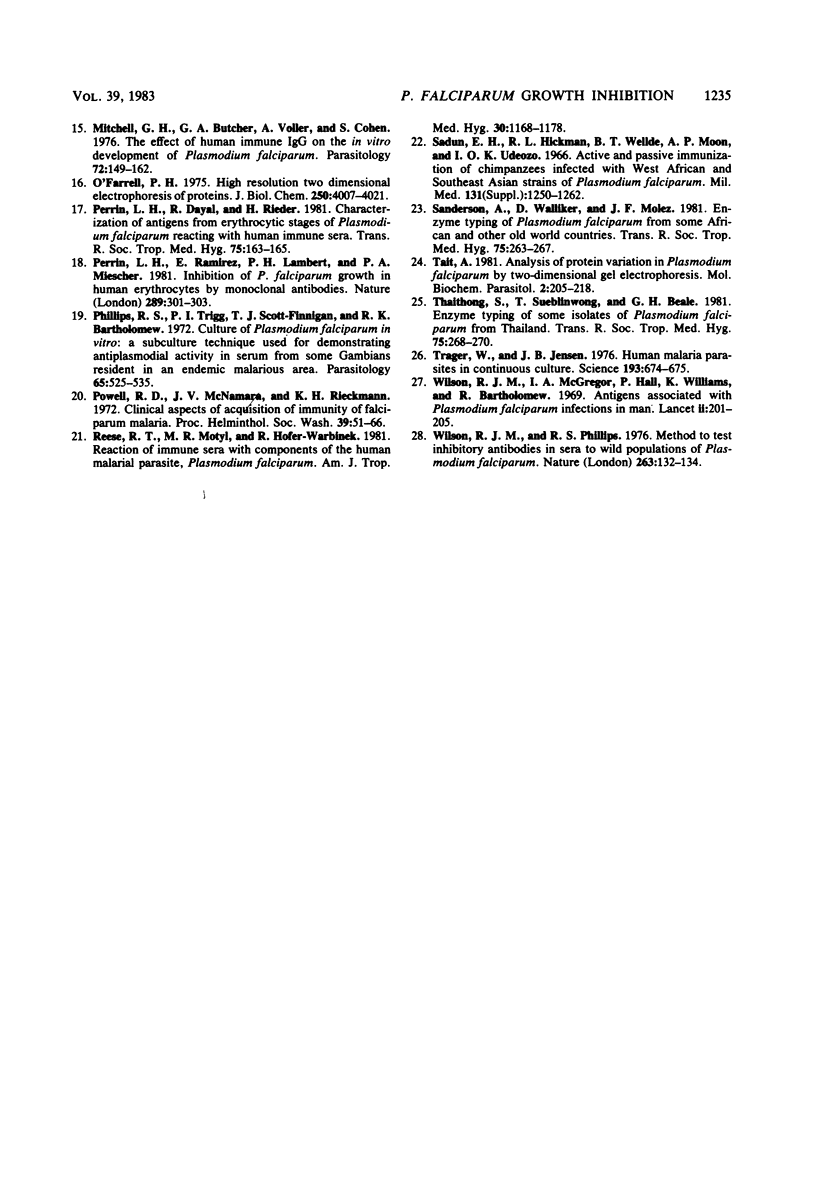Abstract
Immunoglobulin isolated from the sera of individuals living in a malarious area of Papua New Guinea was tested for an effect on the growth in vitro of four isolates of Plasmodium falciparum, three from Papua New Guinea and one from Thailand. The Papua New Guinea isolates were inhibited to the same degree by individual immunoglobulin preparations, and inhibition varied from 0 to 98% (assessed by a radioisotopic readout). Immunoglobulin preparations which inhibited the Papua New Guinea isolates caused less inhibition of the Thai parasites. Biosynthetically labeled parasite proteins were analyzed by two-dimensional gel electrophoresis, and differences were detected in the protein and antigenic composition of isolates which differed in their sensitivity to inhibitory immunoglobulin. Three acidic proteins (Mr 200,000, 150,000, and 65,000) were found only in the Papua New Guinea isolates. All Papua New Guinea isolates contained a high-molecular-weight basic protein with an Mr of 220,000 (Pf220), but the corresponding protein of the same molecular weight in the Thai isolate had a more acidic isoelectric point. Another isolate (from Africa) initially showed a degree of resistance to inhibition by Papua New Guinea immunoglobulin (although not to the same extent as the Thai parasite), but in later experiments, this isolate was susceptible to inhibition. During the course of this series of experiments, the antigenic composition of this (uncloned) isolate changed so that it became similar (but not identical) to the Papua New Guinea isolates.
Full text
PDF







Images in this article
Selected References
These references are in PubMed. This may not be the complete list of references from this article.
- Brown G. V., Anders R. F., Mitchell G. F., Heywood P. F. Target antigens of purified human immunoglobulins which inhibit growth of Plasmodium falciparum in vitro. Nature. 1982 Jun 17;297(5867):591–593. doi: 10.1038/297591a0. [DOI] [PubMed] [Google Scholar]
- Brown G. V., Anders R. F., Stace J. D., Alpers M. P., Mitchell G. F. Immunoprecipitation of biosynthetically-labelled proteins from different Papua New Guinea Plasmodium falciparum isolates by sera from individuals in the endemic area. Parasite Immunol. 1981 Winter;3(4):283–298. doi: 10.1111/j.1365-3024.1981.tb00407.x. [DOI] [PubMed] [Google Scholar]
- Brown G. V., Coppel R. L., Vrbova H., Grumont R. J., Anders R. F. Plasmodium falciparum: comparative analysis of erythrocyte stage-dependent protein antigens. Exp Parasitol. 1982 Apr;53(2):279–284. doi: 10.1016/0014-4894(82)90070-4. [DOI] [PubMed] [Google Scholar]
- COHEN S., McGREGOR I. A., CARRINGTON S. Gamma-globulin and acquired immunity to human malaria. Nature. 1961 Nov 25;192:733–737. doi: 10.1038/192733a0. [DOI] [PubMed] [Google Scholar]
- Carter R., McGregor I. A. Enzyme variation in Plasmodium falciparum in the Gambia. Trans R Soc Trop Med Hyg. 1973;67(6):830–837. doi: 10.1016/0035-9203(73)90011-4. [DOI] [PubMed] [Google Scholar]
- Carter R., Voller A. The distribution of enzyme variation in populations of Plasmodium falciparum in Africa. Trans R Soc Trop Med Hyg. 1975;69(4):371–376. doi: 10.1016/0035-9203(75)90191-1. [DOI] [PubMed] [Google Scholar]
- Chen P., Lamont G., Elliott T., Kidson C., Brown G., Mitchell G., Stace J., Alpers M. Plasmodium falciparum strains from Papua New Guinea: culture characteristics and drug sensitivity. Southeast Asian J Trop Med Public Health. 1980 Dec;11(4):435–440. [PubMed] [Google Scholar]
- Cohen S., Butcher G. A., Crandall R. B. Action of malarial antibody in vitro. Nature. 1969 Jul 26;223(5204):368–371. doi: 10.1038/223368a0. [DOI] [PubMed] [Google Scholar]
- Jensen J. B., Trager W. Plasmodium falciparum in culture: use of outdated erthrocytes and description of the candle jar method. J Parasitol. 1977 Oct;63(5):883–886. [PubMed] [Google Scholar]
- Kilejian A. Stage-specific proteins and glycoproteins of plasmodium falciparum: identification of antigens unique to schizonts and merozoites. Proc Natl Acad Sci U S A. 1980 Jun;77(6):3695–3699. doi: 10.1073/pnas.77.6.3695. [DOI] [PMC free article] [PubMed] [Google Scholar]
- Laemmli U. K., Favre M. Maturation of the head of bacteriophage T4. I. DNA packaging events. J Mol Biol. 1973 Nov 15;80(4):575–599. doi: 10.1016/0022-2836(73)90198-8. [DOI] [PubMed] [Google Scholar]
- Mitchell G. H., Butcher G. A., Voller A., Cohen S. The effect of human immune IgG on the in vitro development of Plasmodium falciparum. Parasitology. 1976 Apr;72(2):149–162. doi: 10.1017/s0031182000048459. [DOI] [PubMed] [Google Scholar]
- O'Farrell P. H. High resolution two-dimensional electrophoresis of proteins. J Biol Chem. 1975 May 25;250(10):4007–4021. [PMC free article] [PubMed] [Google Scholar]
- Perrin L. H., Dayal R., Rieder H. Characterization of antigens from erythrocytic stages of Plasmodium falciparum reacting with human immune sera. Trans R Soc Trop Med Hyg. 1981;75(1):163–165. doi: 10.1016/0035-9203(81)90055-9. [DOI] [PubMed] [Google Scholar]
- Perrin L. H., Ramirez E., Lambert P. H., Miescher P. A. Inhibition of P. falciparum growth in human erythrocytes by monoclonal antibodies. Nature. 1981 Jan 22;289(5795):301–303. doi: 10.1038/289301a0. [DOI] [PubMed] [Google Scholar]
- Phillips R. S., Trigg P. I., Scott-Finnigan T. J., Bartholomew R. K. Culture of Plasmodium falciparum in vitro: a subculture technique used for demonstrating antiplasmodial activity in serum from some Gambians, resident in an endemic malarious area. Parasitology. 1972 Dec;65(3):525–535. doi: 10.1017/s0031182000044139. [DOI] [PubMed] [Google Scholar]
- Reese R. T., Motyl M. R., Hofer-Warbinek R. Reaction of immune sera with components of the human malarial parasite, Plasmodium falciparum. Am J Trop Med Hyg. 1981 Nov;30(6):1168–1178. doi: 10.4269/ajtmh.1981.30.1168. [DOI] [PubMed] [Google Scholar]
- Sadun E. H., Hickman R. L., Wellde B. T., Moon A. P., Udeozo I. O. Active and passive immunization of chimpanzees infected with West African and Southeast Asian strains of Plasmodium falciparum. Mil Med. 1966 Sep;131(9 Suppl):1250–1262. [PubMed] [Google Scholar]
- Sanderson A., Walliker D., Molez J. F. Enzyme typing of Plasmodium falciparum from African and some other Old World countries. Trans R Soc Trop Med Hyg. 1981;75(2):263–267. doi: 10.1016/0035-9203(81)90331-x. [DOI] [PubMed] [Google Scholar]
- Tait A. Analysis of protein variation in Plasmodium falciparum by two-dimensional gel electrophoresis. Mol Biochem Parasitol. 1981 Feb;2(3-4):205–218. doi: 10.1016/0166-6851(81)90101-8. [DOI] [PubMed] [Google Scholar]
- Thaithong S., Sueblinwong T., Beale G. H. Enzyme typing of some isolates of Plasmodium falciparum from Thailand. Trans R Soc Trop Med Hyg. 1981;75(2):268–270. doi: 10.1016/0035-9203(81)90332-1. [DOI] [PubMed] [Google Scholar]
- Trager W., Jensen J. B. Human malaria parasites in continuous culture. Science. 1976 Aug 20;193(4254):673–675. doi: 10.1126/science.781840. [DOI] [PubMed] [Google Scholar]
- Wilson R. J., McGregor I. A., Hall P., Williams K., Bartholomew R. Antigens associated with Plasmodium falciparum infections in man. Lancet. 1969 Jul 26;2(7613):201–205. doi: 10.1016/s0140-6736(69)91437-8. [DOI] [PubMed] [Google Scholar]
- Wilson R. J., Phillips R. S. Method to test inhibitory antibodies in human sera to wild populations of Plasmodium falciparum. Nature. 1976 Sep 9;263(5573):132–134. doi: 10.1038/263132a0. [DOI] [PubMed] [Google Scholar]





